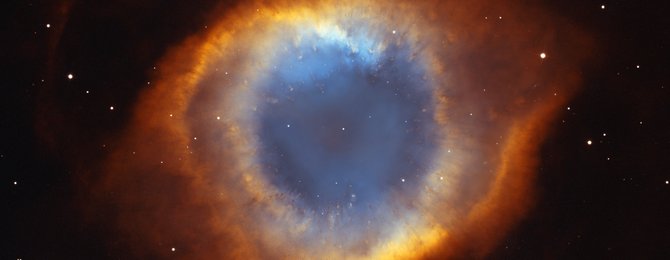

Just about every clump of ice, rock or gas in our solar system, from Halley’s comet to Earth to Jupiter, formed the same way: from a swirling cloud of dust and gas left over after the birth of the sun. So when astronomers spotted an unknown object coming screaming in from interstellar space with an evaporating, comet-like plume behind it, they naturally assumed it to have originated similarly around some other star.
But what if it didn’t? What if Borisov, as the interstellar visitor is known, represents the first example of a whole new way to make a comet? Marshall Eubanks, a physicist at the private company Space Initiatives, has been pondering whether the cosmic gunk surrounding dying stars could pull off similar acts of creation since his days at NASA’s Jet Propulsion Laboratory in the 1980s. If clouds expelled by sputtering stars do draw together into solid masses, interstellar space could be full of such dark, comet-like objects. And Borisov could represent a fleeting opportunity, he argues in a recent arXiv preprint, for astronomers to study this otherwise invisible process.
“This is like a movie they bring out of the vault once in a while,” Eubanks says. “It’s going to be gone soon and we’ve got to figure out what we’re going to do now.”
Making a comet—or a planet for that matter—requires two simple conditions. There has to be enough dust and gas for gravity to pull the ingredients together, and there can’t be so much motion that it carries the materials apart. Our solar system satisfied these conditions in its youth, and Eubanks wonders if it might go through a second burst of world-creation in its old age.
As sun-like stars (those between roughly one and ten times the mass of our sun) run out of fuel, they puff up into red giants, undergo violent convulsions that dredge up and expel carbon and oxygen from their cores, and eventually collapse into small but radiant white dwarf stars. Those brilliant remnants act like floodlights for astronomers, illuminating all the material thrown out by the stars during their deaths—vast and photogenic gas and dust bubbles known as “planetary nebulae.”
Closer observations of these nebulae have revealed giant balls of gas as big as our entire solar system flying away from their host star. With as much mass as the Earth or more, these “cometary knots” have more than enough material to form Borisov-like objects. And with their stars shining quietly in the white dwarf phase, the knots just might actually remain peaceful enough to pull themselves together. Moreover, because solar systems spew out much more material in their deaths than they do in their births, Eubanks says, it stands to reason that most interstellar voyagers come from that end of their lifespan.
That makes Borisov a prime candidate for a “stardust comet,” as he calls it, and early observations haven’t ruled out the exotic possibility. The ingredients that would go into a such a hypothetical comet differ from those that go into the standard planetary ones. Many would be chock full of particular forms of carbon, for instance, dredged up from the star’s core during its convulsions. Carbon tends to absorb oxygen, preventing it from forming water, which Eubanks says could explain why Borisov looks so dry.
He also traced the comet’s trajectory backwards out into space, and Borisov seems to have originated from a stream of similar stars known as the Wolf 360 stream. Had the stellar entourage been youthful, the theory would have been a non-starter. But the stream appears old enough that dead members could plausibly be sending out carbon-rich emissaries.
Eubanks also makes predictions for the specific amount of various ingredients that should be visible in Borisov’s tail, if it really is a stardust comet. “The thing is it’s testable,” he says “There’s either water there or there’s not. There’s either silicon carbide there or it’s not. And you should be able to look with a good telescope and see.”
He hopes that the paper, which is currently under peer review by The Astrophysical Journal Letters, will inspire astronomers to make the appropriate measurements this spring, while Borisov moves out of the sun’s glare but before it gets too far away. “From now until March is the time to resolve stuff like that,” he says. “And in a year, it will be too late.”
Other researchers say that the idea needs more theoretical work. “It introduces some unspoken miracles,” says Bob O’Dell, an astronomer at Vanderbilt University who has devoted his career to the study of planetary nebulae. He questions whether fragile cometary knots can survive long enough to pull together into solid objects, but finds the notion that Borisov could be the crystallization of such far-off entities exciting. “For people like myself that have been fascinated with condensations in planetary nebula,” he says, “it’s nice to see they could be leading to things that you can see close up.”
If even a small portion of the material spit out by dying stars ends up as chunky solid matter, they would litter the space between stars with Borisov-like comets, which could in turn update theories about how solar systems come together. “The interstellar medium [would be like] raisin bread,” O’Dell says, “and that alters the processes by which planets form.”
Astronomers may have gotten lucky with the back-to-back discoveries of Borisov and its mysterious predecessor ‘Oumuamua, but next-generation sky scanning instruments, such as the upcoming Large Synoptic Survey Telescope (LSST) will help astronomers conduct a more thorough census of what kinds of objects come whizzing through our solar system starting in 2023. “The LSST should find things like Borisov and ‘Oumuamua by the boatload, Eubanks says. “We have a chance to start answering those questions.”
